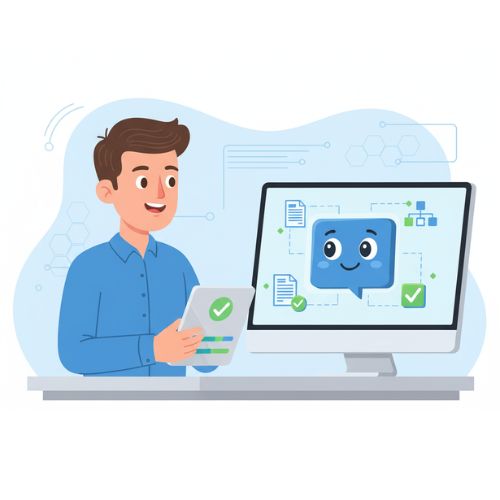AI for Risk Assessment in Compliance
Compliance teams face mounting pressures to identify and mitigate risks effectively. Traditional methods often fall short, relying on manual processes that are time-consuming and prone to human error. Enter artificial intelligence (AI)—a game-changer that's revolutionizing how organizations handle risk assessment in compliance. By leveraging AI, companies can predict potential issues, automate monitoring, and ensure adherence to standards like ISO 13485 or GDPR with greater accuracy and speed.
In this post, we'll explore how AI is reshaping risk assessment, its benefits, challenges, and practical applications.
What is Risk Assessment in Compliance?
Risk assessment in compliance involves identifying, analyzing, and evaluating potential threats that could lead to non-compliance with laws, regulations, or internal policies. This process is crucial for preventing financial penalties, reputational damage, and operational disruptions. Traditionally, it includes steps like data collection, risk scoring, and mitigation planning.
However, with the rise of complex global regulations, manual assessments are becoming obsolete. AI steps in by processing vast amounts of data in real-time, uncovering hidden patterns that humans might miss.
{{cta}}
How AI Transforms Risk Assessment
AI brings advanced capabilities to compliance risk management, making it more proactive and efficient. Here's how:
Predictive Analytics for Early Risk Detection
AI algorithms, powered by machine learning, analyze historical data to forecast future risks. For instance, in the financial services sector, AI can identify unusual transactions that may indicate money laundering or fraud. This predictive power allows compliance officers to address issues before they escalate.
In quality management systems (QMS), AI can predict deviations in manufacturing processes, ensuring adherence to standards like ISO 13485.
Automation of Monitoring and Reporting
Gone are the days of sifting through spreadsheets. AI automates continuous monitoring, scanning documents, emails, and databases for compliance violations. Tools like natural language processing (NLP) can review contracts or policies to identify gaps.
For example, generative AI can draft risk and control self-assessments, saving hours of manual work. This is particularly useful in sectors such as medical devices, where Botable's AI chatbots provide instant access to regulatory updates.
Enhanced Data Analysis and Decision-Making
AI handles massive datasets with speed and precision, utilizing techniques such as anomaly detection to identify irregularities. In internal audits, AI-powered tools predict emerging risks by analyzing patterns, enabling proactive interventions.
Integrating AI into your QMS can also facilitate root cause analysis, as seen in our guide on AI for root cause analysis.
{{cta}}
Benefits and Challenges of Using AI for Risk Assessment in Compliance
Artificial intelligence (AI) is emerging as a powerful tool for risk assessment and management. Organizations are increasingly turning to AI to navigate complex regulations, predict potential threats, and streamline processes. However, while AI offers transformative benefits, it also presents unique challenges that must be addressed for successful implementation.
At Botable.ai, we specialize in AI-powered solutions that enhance compliance workflows through intuitive chatbots. Our tools integrate seamlessly into systems like quality management (QMS) and policy management, helping teams in sectors such as manufacturing and medical devices stay ahead of risks. In this post, we'll delve into the key benefits and challenges of utilizing AI for risk assessment in compliance, drawing on current trends to inform your strategy.

Enhanced Predictive Capabilities
AI excels at forecasting risks by analyzing patterns in historical data. For instance, machine learning algorithms can detect emerging threats in real-time, allowing auditors and compliance officers to intervene before issues escalate. This predictive power is particularly valuable in dynamic environments, such as financial services or healthcare, where regulations like ISO 13485 require vigilant monitoring. Tools like our AI for root cause analysis chatbot can help pinpoint deviations early, reducing the likelihood of non-compliance.
Improved Decision-Making Speed and Accuracy
With AI, decision-making becomes faster and more precise. Automated systems minimize human error by evaluating risks based on data-driven insights rather than intuition. By 2025, over half of major enterprises are expected to utilize AI for continuous regulatory checks, resulting in faster responses to potential violations. This accuracy not only boosts confidence in compliance strategies but also frees up teams for higher-level tasks, as seen in our Capa system AI guide.
Automated Monitoring and Efficiency Gains
Manual risk assessments are labor-intensive, but AI automates ongoing monitoring of documents, transactions, and processes. Natural language processing (NLP) can scan policies and contracts for gaps, while anomaly detection flags irregularities instantly. This automation results in significant cost savings by preventing fines and operational disruptions. For compliance in quality assurance, explore how our solutions streamline this in the quality assurance department.
Scalability and Risk Mitigation
As businesses grow, so do their data volumes and regulatory demands. AI scales effortlessly, handling increased complexity without proportional resource hikes. Regular AI-driven assessments mitigate risks more effectively, ensuring adherence to standards like GDPR or ISO 9001. Our AI QMS checklist offers a practical framework for leveraging these benefits.
Ethical and Strategic Advantages
Beyond technical benefits, AI promotes ethical compliance by identifying biases in processes and suggesting more equitable alternatives. This strategic edge helps organizations build trust and maintain a competitive advantage in regulated industries.
{{cta}}
Major Challenges and Strategies to Overcome Them
Despite its advantages, integrating AI into compliance risk assessment isn't without obstacles. Addressing these proactively is key to harnessing AI's full potential. Here's a look at the primary challenges in 2025 and how to tackle them:
Data Privacy and Security Concerns
AI systems rely on sensitive data, which raises the risk of breaches or misuse. In an era of stringent privacy laws, ensuring data protection is paramount. Solution: Implement robust encryption and comply with frameworks like NIST's AI Risk Management. At Botable.ai, our privacy department tools help safeguard information while enabling secure AI deployments.
Algorithmic Bias and Fairness Issues
Biased AI models can perpetuate inequalities, leading to flawed risk assessments. This is especially critical in compliance, where fairness is non-negotiable. Solution: Use diverse training datasets and conduct regular bias audits. Train teams on ethical AI practices, as discussed in our post on responsible AI in HR, which overlaps with compliance ethics.
.jpg)
Regulatory Compliance for AI Itself
Ironically, AI tools must adhere to evolving regulations, creating a compliance loop. New laws in 2025 demand transparency in AI operations. Solution: Stay updated with AI governance strategies and integrate compliance by design. Our use of AI for compliance blog offers insights into navigating these requirements.
Lack of Transparency and Accountability
AI's "black box" nature makes it hard to explain decisions, complicating audits. Solution: Adopt explainable AI (XAI) models that provide clear rationales for outputs. Foster accountability through cross-departmental oversight, similar to how our information technology department supports AI integrations.
Integration and Adoption Hurdles
Implementing AI requires technical expertise and cultural buy-in, which can slow adoption. Solution: Start with a crawl-walk-run approach, as outlined in our guide to AI chatbots in QMS. Partner with experts like Botable.ai for seamless integration via platforms like Slack or Microsoft Teams.
By addressing these challenges head-on, organizations can maximize AI's benefits while minimizing downsides.
{{cta}}
AI is not just a tool; it's a strategic ally in mastering risk assessment for compliance. By predicting risks, automating processes, and providing actionable insights, AI enables teams to stay ahead of regulatory requirements. At Botable.ai, our AI solutions are designed to make compliance effortless, whether through chatbots for quality assurance or information technology.
Start your journey today and transform your compliance strategy. For more insights, browse our blog or explore related topics, such as using AI for compliance.
Answers your employees need, right when they need them
Meet Botable — the AI chatbot that handles everything from simple FAQs to complex, multi-step questions, so your team can focus on what matters. Built for HR, QA, and beyond.
Continue reading
Ready to see what Botable can do for you?
Book your demo now to see how Botable can transform your workplace.
Identify your unique challenges
Flexible pricing options
Easy integrations
Step-by-step implementation plan
Customize Botable for your workflow
Book a demo
.webp)



